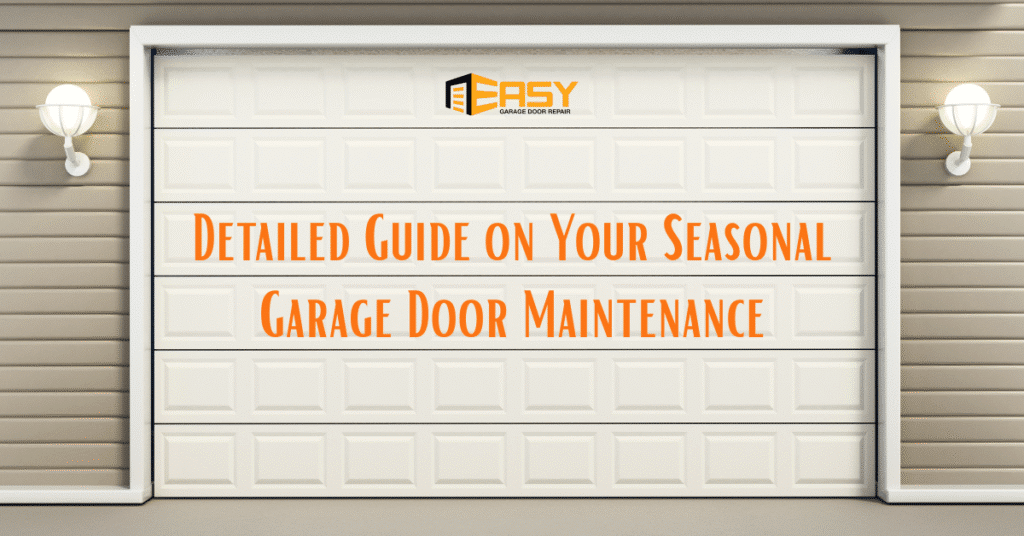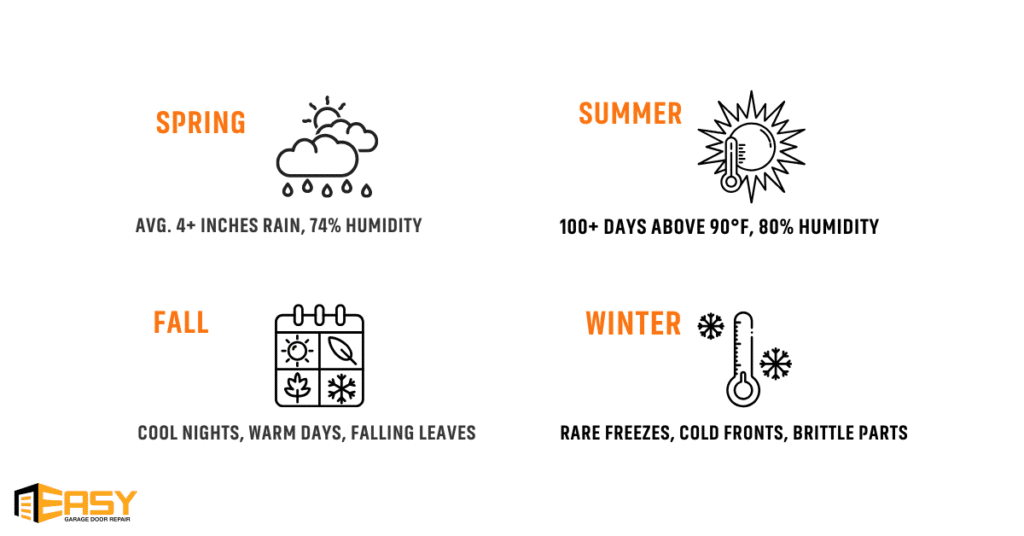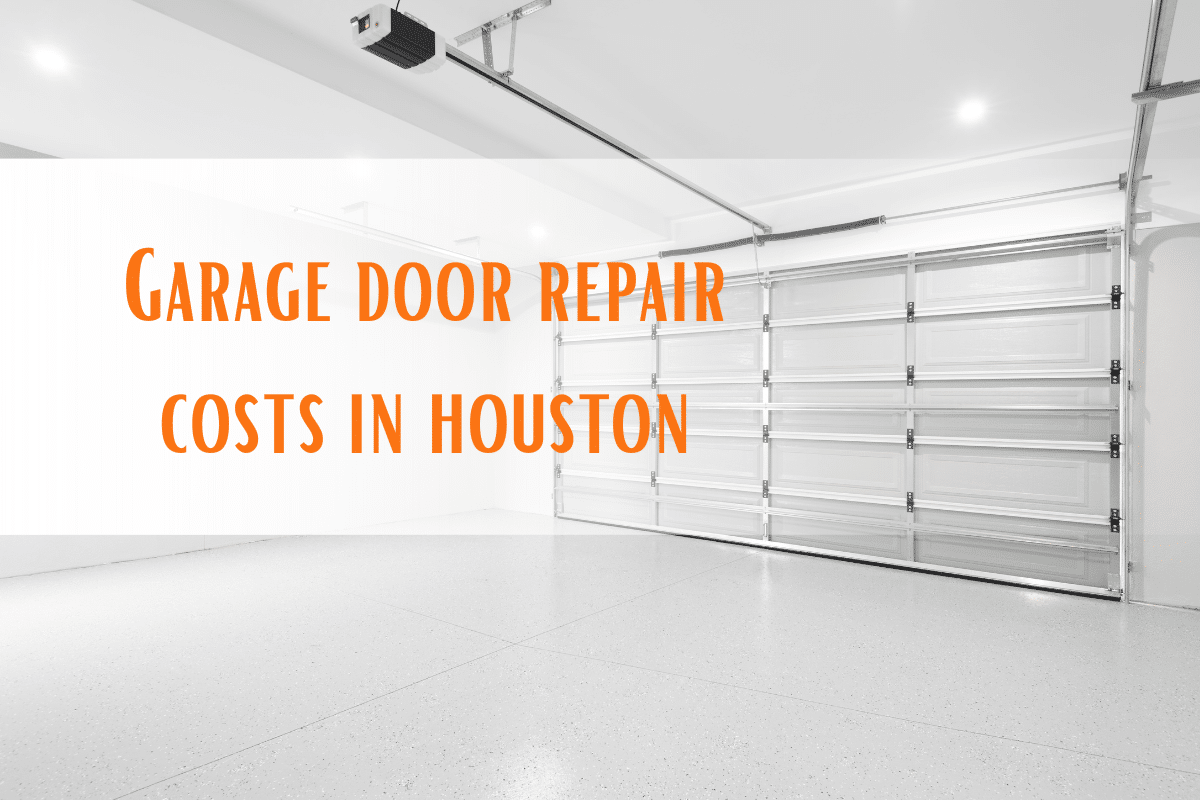
Your garage door faces different challenges every season in Houston. Heavy rain, intense summer heat, humidity, and winter freezes all affect door performance. Houston regularly sees temperatures above 95°F. This causes spring metal to expand, lose elasticity, and accelerate fatigue.
Houston’s humidity stays above 80% most of the year, and moisture gathers on parts of the door. The city also experiences heavy spring rain and occasional cold snaps in winter. Without seasonal garage door maintenance, your door may fail to respond at the worst possible time, of a snowstorm or a summer heatwave.
Over time, these changing conditions damaged springs, panels, and weather seals. Year-round garage door upkeep protects your investment and ensures your garage door security.
This guide to seasonal garage door upkeep helps you keep your garage door safe for all seasons.
Why Is Seasonal Garage Door Maintenance Necessary?
Garage doors are one of the most neglected systems in the average home. Poor seasonal upkeep can cost you the average repair $400+ while a full replacement can soar as high as $6,000+.
Seasonal garage door maintenance checks catch problems before parts fail. Well-maintained doors reduce the risk of injury or collapse. Garage door services that offer seasonal checkups can help your system last over 15 years.
Don’t have time for that? We will do it for you with our professional regular maintenance service.
Garage Door Maintenance for Spring Season
Spring in Houston brings heavy rainfall and high humidity. The city averages over 4 inches of rain, and humidity levels often reach over 74% in April. Temperatures gradually rise from 60°F to 85°F, and this affects both metal and wood garage doors
Spring is the perfect time to give your garage door a fresh start. Humid air causes metal parts to oxidize faster. Springs may show signs of wear, like surface rust. Hinges may squeak or stick. Wood doors absorb moisture, which makes them expand. This creates alignment issues and stress on the opener.
Drafts and moisture also seep under the bottom seal. This causes mold rot and a weakened barrier against pests. The garage door opener may lag if moisture affects its sensors or internal electronics.
Inspect all metal parts weekly: Check springs, hinges, and rollers. Look for signs of rust or a dull surface. Use a clean cloth to wipe the moisture. Remove surface rust with steel wool or a wire brush.
Apply rust protection spray: Use a PTFE or silicone-based spray on springs and moving joints. Do this every three months during humid weather. It creates a dry shield that stops rust from forming again.
Test door balance: Disconnect the opener. Manually lift the door halfway. If it slides down or shoots up the springs are not balanced. Call a certified technician if this happens.
Examine the bottom seal: If the seal feels soft, sticky or cracked, replace it. A good seal at the bottom of the door keeps water, insects, and dust out of the garage.
Wipe the tracks and clean sensors: Dirt builds up faster in spring storms. Use a soft cloth to clean the tracks. Clean the photo-eye sensors to prevent opener issues.
Check for water pooling near the door: Spring storms in Houston often flood streets and driveways. Make sure the garage threshold slopes away from the home. Install a door threshold seal if water keeps getting inside.
Control indoor humidity: Use a wall vent or portable dehumidifier to keep garage moisture levels below 60%. This helps protect metal parts from rust and prevents swelling in wood doors.

Garage Door Maintenance for the Summer Season
Summer in Houston is long, hot, and intense. Daily high temperatures stay above 90°F for over 100 days. Inside a closed garage, the temperature can reach 110°F or more. Humidity often stays 80% especially in June. These extreme conditions create several issues for garage doors and their components.
Heat causes metal parts to expand. This includes springs, tracks, and hinges. Expansion leads to misalignment and pressure on the opener. Springs may lose tension faster in high heat. This makes the door feel heavier and harder to lift.
Sensors and remotes may fail if the circuit boards overheat. High humidity during summer also encourages rust on unprotected metal surfaces. If the garage is not ventilated, moisture builds up inside. This damages both steel and wood doors. Wood doors may warp or develop cracks in the panels.
Inspect and lubricate all moving parts: Use a silicone-based spray on springs, hinges, and rollers. Reapply lubricant mid-season. Heat breaks down lubrication faster in summer. Do not use oil-based sprays because they attract dust and dry out.
Check spring tension monthly: Lift the door halfway after disconnecting the opener to check the balance. If it does not stay in place, the springs are likely stretched. Avoid using the door frequently if this test fails. Contact a technician for inspection.
Tighten bolts and track hardware: Heat expansion causes bolts and nuts to loosen. Use a wrench to gently tighten any visible hardware. Do not over-tighten.
Clean and align sensors: Dust builds up quickly in summer, especially in garages without insulation. Wipe the photo eye sensors with a soft, dry cloth. Make sure they are aligned and their indicator lights stay solid.
Monitor your garage opener: Check if the opener feels hot after one or two uses. Give it time to cool between cycles if it stalls. Install a fan or vent near the motor if the garage traps heat.
Use insulation to block heat: Install reflective insulation panels inside the garage door. This reduces the internal temperature and protects the spring and motor life. Insulation also lowers cooling costs for garages attached to your home.
Improve airflow inside the garage: Keep a small window slightly open or install passive wall vents. This reduces trapped heat and keeps humidity lower.

Garage Door Maintenance for Fall Season
Fall in Houston brings a mix of warm afternoons and cool nights. Humidity remains high in early fall, then drops slightly in late October. Rainfall is still frequent, with over 4 inches of rain in September and around 3 inches in October. These shifting conditions affect how garage door parts function.
Daily temperature swings cause metal parts to expand and contract. This weakens springs, rollers, and tracks over time. The back-and-forth motion can lead to loose screws and misaligned brackets. Wooden garage doors absorb fall moisture and begin to swell. This makes the door heavy and harder for the opener to lift.
Fall leaves and debris also collect near the door base and inside the tracks. This can block the door path and damage rollers. Dust and pollen buildup in fall also interfere with photo-eye sensors. If left uncleaned, the door may stop closing properly.
Inspect door tracks and rollers weekly: Look for leaves, dirt, or small twigs stuck in the tracks. Clean the tracks using a dry brush or vacuum. Check rollers for smooth movement. Replace any roller that sticks or makes noise.
Tighten loose hardware: Use a wrench to secure any bolts or brackets that may have loosened during summer heat. This prevents parts from shifting when the weather cools down.
Test spring tension and door balance: Lift the garage door halfway after disconnecting the opener. If the door moves, the springs are not balanced. This test is important before cold weather begins.
Lubricate all moving parts: Apply silicone lubricant to springs, hinges, and rollers. Do this early in the season to avoid wear and tear. It helps parts stay flexible through cooler temperatures. Reapply mid-season if parts feel dry or noisy.
Check and clean sensors: Wipe the sensor lenses with a soft cloth. Dust and leaves from fall winds often block the beam. Misaligned sensors cause the door to reverse or stay open.
Inspect and replace weather stripping: If the bottom seal is cracked, swollen, or peeling, replace it. A good seal keeps out cold air, pests, and rainwater.
Remove moisture inside the garage: Use a dehumidifier or open a wall vent during damp weeks. This seasonal garage door maintenance step reduces rusting and protects stored items inside the garage.
Garage Door Maintenance for Winter Season

Houston winters are mild but unpredictable. Temperatures usually stay between 45°F and 65°F, but can suddenly drop below 30°F during cold fronts. While extreme cold cause the door to get stuck and create serious problems.
Cold air makes metal parts contract. Springs become brittle and more likely to snap. Rollers can stiffen and make grinding noises. Lubricants may thicken or dry out. Openers can slow down, and sensors may stop working in low temperatures.
Moisture that enters the tracks during rainy days can freeze and block door movement. Ice buildup at the bottom seal can also keep the door from closing fully. Even a mild cold affects wood doors. They may shrink or develop gaps that let in cold air and water.
Insulate your garage door: Add foam panels or reflective insulation to the inside of the door. Insulated garage doors retain heat inside and protect components from freezing damage. It also reduces stress on the opener and improves indoor comfort.
Lubricate with cold-safe product: Use a lithium-silicone-based lubricant that stays smooth in freezing temperatures. Apply it to springs, hinges, and rollers. Do this at the start of winter and reapply if parts start squeaking or grinding.
Warm up frozen parts gently: Use a dry cloth or hairdryer to warm them before opening the door. Never use hot water. It may cause the metal to crack or create slippery ice.
Check door balance and spring tension: Lift the door manually halfway. If it drops or rises, the spring may have lost tension. This is more common in winter because of metal contraction.
Test the opener and sensors: Watch how the opener responds. If it moves slowly or struggles, stop using it. Cold weather may affect the motor. Clean the photo eye sensors with a soft, dry cloth. Make sure they are aligned. Cold air and dirt can block the beam and cause a malfunction.
Replace brittle weather stripping: If the rubber seal at the bottom is stiff, cracked, or frozen, replace it. A flexible seal blocks cold air, water, and ice from entering the garage.
Keep the garage dry: Wipe any water that collects near the door. Use a dehumidifier or small heater to reduce moisture buildup. This prevents rust on springs and tracks.
Limit opener cycles on freezing days: If temperatures are near freezing, use the door less often. This reduces strain on the springs and motor. Let the system rest between uses to avoid overheating. Winterize your garage door fully by combining all these steps.

Final Thoughts
Garage doors open and close thousands of times a year through heat, cold, rain, and snow. Routine seasonal maintenance is the easiest way to avoid big problems. It keeps springs strong, opener responsive, seals tight, and ensures the door run smoothly.
Regular seasonal garage door maintenance prevents sudden failures and expensive repairs. Easy Garage Door Repair professionals make that care simple for you. We offer reliable installation, maintenance, and emergency repair services across Houston and nearby areas.
Don’t wait for failure. Call a professional garage door technician for a perfect time seasonal tune-up today.








